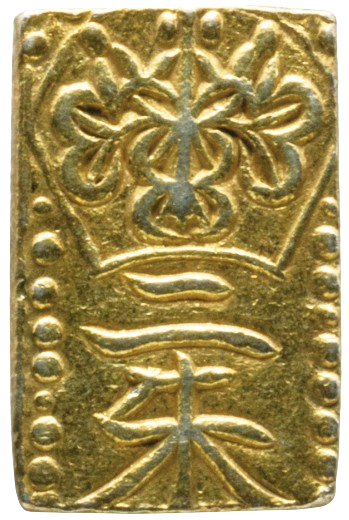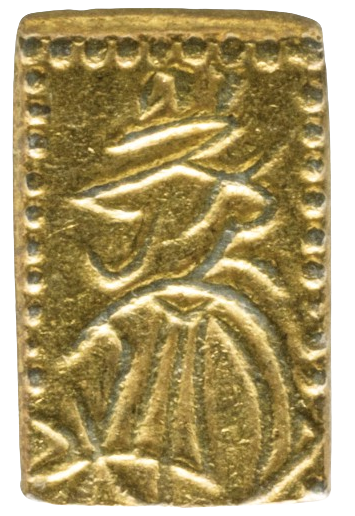Tenpō Nishū Ban Kin
(天保二朱判金)


(Ginza Coins Collection, Tokyo. Reproduction authorized. © All rights reserved.)
ssued in 1837 during the Tenpō era (1830–1844), the Tenpō Nishū Ban Kin emerged amid economic crisis, famine, and monetary instability. The Tokugawa government introduced it to boost currency circulation, while reducing its gold content to preserve dwindling precious metal reserves. This strategy, designed to generate fiscal revenue through the gap between face value and intrinsic value, earned the shogunate over one million ryō. However, the coin’s lower gold quality sparked distrust among merchants and encouraged counterfeiting, as shown by a 1840 case in Osaka, where fake coins made with even poorer alloys were uncovered. The Tenpō Nishū Ban Kin remained in circulation until 1866, when it was replaced by the Man’en Nishū Ban Kin, marking a step toward the monetary reforms of the Meiji era.
| Coin Name | Tenpō Nishū Ban Kin |
| Japanese Inscription | 天保二朱判金 |
| Historical Period | Edo Period (1603-1868 d.C.) |
| Year of Minting | 1832 – 1858 d.C. |
| Chronological Reference | Japan |
| Minting Location | Edo |
| Issuing Authority | Clan Tokugawa (Tokugawa Iesada) |
| Function | Officially minted Value 2 Shū |
| Material | Gold (29.9 %) Silver (14.3 %) Other (55.8 %) |
| Shape | Rectangular |
| Height | 1.4 cm |
| Width | 0.8 cm |
| Weight | 1.64 g |
| Manufacturing Technique | Mold casting |
| Obverse Text and Symbols | Gosan Kiri inscribed in a fan-shaped design Character Ni 二 (two) Character Shū 朱 |
| Reverse Text and Symbols | Inscription Mitsutsugu (光次) and kaō |
| Calligrapher / Artist: | Gotō San’emon Mitsumichi |
| Museum References | |
| Number of Known Specimens | 103,000,000 pieces produced |
Sources and Bibliography
The Gold of Tokugawa, Alberto Rolfini 2025
瀧澤武雄, 貨幣 Takizawa Takeo, Kahei Nipponshi sho Hyakka 1999
